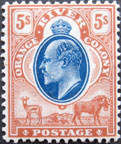User: WINHOST\pool115776494
STAMPS
Basic Designs
The first postage stamps (values one penny, sixpence and one shilling) were printed by De La Rue in London in 1867 and issued in the Free State on 1st January 1868, but these had been preceded by revenue stamps, which had been home produced in an embossed form, and used since 1856.
With postal rate changes new postage values were introduced, but no change was made in the basic design of the olive tree with powder horns until the republic became a British colony in 1903 when a new design incorporated the head of King Edward VII.
The embossed revenue stamps were superseded by printed ones in 1877 with a new design which again continued in use until new ones were designed for the Edwardian period.
In addition, the Free State had a Mounted Police force which had its own official stamps, and when the war started in 1899 the Boers printed their own postage labels, known as "Commando Briefs".

1. 1856 - the first revenues embossed on different colour papers; a four shillings value on white paper.

2. 1868 - an olive tree design for the first postage stamps; the one penny was for newspapers.

3. 1877 - the first printed revenues, three separate designs for the sixpence, shilling and pound values; the sixpence.

4. The nine shillings value.

5. The five pounds value.

6. 1896 - The R.D.M. (Rijdende Dienst Macht) or Mounted Police Force frank - the first design format.

7. The R.D.M. - the second format.

8. The R.D.M. - the third format.

9. 1899 - A Commando Brief frank used at Modder River in the Cape.

10. 1903 - the Edwardian postage stamps; lower values in monocolour; the one penny.

11. The 4d, 6d, 1s. and 5s. in bi-coloured; the five shillings value.

12. 1903 - the Edwardian revenue stamps; all values bi-coloured
Home